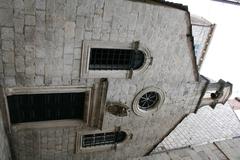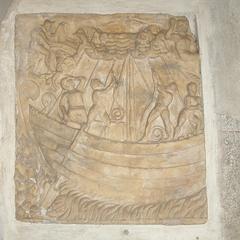Visiting Casa Bossi: History, Tickets, Hours, and Travel Tips
Date: 17/08/2024
Introduction
Casa Bossi, located in the heart of Novara, Italy, is a remarkable example of 19th-century neoclassical architecture designed by the illustrious Alessandro Antonelli. It serves as a vivid symbol of the city’s rich cultural and historical fabric. Originally commissioned by the influential Bossi family in the mid-1800s, this architectural marvel has transitioned from a state of neglect to becoming a vibrant cultural hub. In recent years, Casa Bossi has been meticulously restored, and it now stands as a beacon of historical preservation and adaptive reuse. This guide aims to equip potential visitors with comprehensive information, ranging from its architectural significance and historical background to practical details like visiting hours, ticket prices, and travel tips. Whether you are an architecture enthusiast, a history buff, or simply looking for an enriching cultural experience, Casa Bossi offers a unique glimpse into Italy’s historical and architectural heritage (Casa Bossi, Turismo Novara).
Table of Contents
- Introduction
- History of Casa Bossi
- Efforts for Restoration
- Visitor Information
- Current Status and Future Prospects
- Visitor Experience
- FAQ Section
- Conclusion
History of Casa Bossi
Architectural Genesis
Casa Bossi stands as a testament to the architectural prowess of Alessandro Antonelli, one of the most influential architects of the 19th century. Antonelli, renowned for his innovative designs and structural ingenuity, embarked on the construction of Casa Bossi in the early 1850s. The building was commissioned by the Bossi family, prominent local figures who sought a residence that would reflect their status and taste.
Design and Construction
The design of Casa Bossi is a quintessential example of Antonelli’s architectural philosophy, which emphasized harmony with the surrounding landscape and innovative use of space. The villa’s construction began in 1857 and was completed in 1861. Antonelli’s design incorporated elements of neoclassical architecture, characterized by its symmetrical layout, grand columns, and intricate decorative details. The building’s façade is adorned with elegant stucco work and features a series of large windows that allow natural light to flood the interior spaces.
Decline and Neglect
Despite its initial grandeur, Casa Bossi fell into a state of neglect in the latter half of the 20th century. For over thirty years, the villa was left abandoned, suffering from defacement and vandalism. The once-majestic structure became a shadow of its former self, with its architectural features deteriorating due to lack of maintenance and exposure to the elements. This period of decline significantly impacted the building’s structural integrity and aesthetic appeal.
Efforts for Restoration
Architectural and Energetic Requalification
Recognizing the historical and cultural significance of Casa Bossi, efforts to restore and preserve the villa began to gain momentum in the early 21st century. A comprehensive restoration project was proposed, aiming to rehabilitate the building and transform it into a cultural and technological hub. This project, detailed in a thesis by Dario Palladino, focused on the architectural and energetic requalification of the villa, emphasizing environmental sustainability and energy efficiency (Politesi).
Transformation into a Cultural Hub
One of the primary goals of the restoration project was to transform Casa Bossi into a territorial landmark and a center for cultural and technological activities. The vision was to create an advanced cultural technological pole that would serve as a hub for innovation and creativity. This transformation aimed to breathe new life into the villa, making it a vibrant space for community engagement and cultural exchange.
Environmental Sustainability
A significant aspect of the restoration project was its focus on environmental sustainability. The project incorporated energy-saving measures and sustainable building practices to minimize the environmental impact of the restoration work. This included the use of energy-efficient lighting and heating systems, as well as the integration of renewable energy sources. The goal was to create a model of sustainable restoration that could serve as an example for similar projects in the future.
Visitor Information
Visiting Hours and Tickets
Casa Bossi is open to visitors throughout the week. The visiting hours are as follows:
- Monday to Friday: 10:00 AM - 6:00 PM
- Saturday and Sunday: 10:00 AM - 7:00 PM
Tickets can be purchased at the entrance or online through the official Casa Bossi website. The ticket prices are:
- Adults: €10
- Students and Seniors: €7
- Children (under 12): Free
Travel Tips
- Getting There: Casa Bossi is located in the heart of Novara and is easily accessible by public transportation. The nearest train station is Novara Centrale, which is a short walk from the villa.
- Best Time to Visit: Spring and autumn are the best times to visit Casa Bossi, as the weather is mild and the gardens are in full bloom.
Nearby Attractions
While visiting Casa Bossi, be sure to explore other historical sites in Novara, such as the Novara Cathedral, the Broletto, and the Coccia Theatre. These attractions offer a deeper insight into the rich cultural heritage of the region.
Accessibility
Casa Bossi is committed to providing accessibility for all visitors. The villa is equipped with ramps and elevators to ensure that individuals with mobility challenges can enjoy the site.
Current Status and Future Prospects
As of 2024, Casa Bossi stands as a symbol of successful restoration and adaptive reuse. The villa has been revitalized and now serves as a cultural and technological hub, hosting a variety of events and activities that engage the local community and attract visitors from around the world. The restoration project has not only preserved the historical and architectural significance of Casa Bossi but has also created a dynamic space that contributes to the cultural and economic vitality of Novara.
Visitor Experience
Visitors to Casa Bossi can explore the villa’s beautifully restored interiors, which showcase the intricate architectural details and elegant design elements that define Antonelli’s work. The villa also hosts a range of exhibitions, workshops, and cultural events, providing visitors with a rich and immersive experience. Additionally, the surrounding gardens and landscape offer a tranquil setting for leisurely walks and outdoor activities.
FAQ Section
Q: What are the visiting hours for Casa Bossi?
A: Casa Bossi is open from Monday to Friday, 10:00 AM - 6:00 PM, and on weekends from 10:00 AM - 7:00 PM.
Q: How much are the tickets to visit Casa Bossi?
A: Tickets are priced at €10 for adults, €7 for students and seniors, and free for children under 12.
Q: Are there guided tours available at Casa Bossi?
A: Yes, guided tours are available and can be booked in advance through the official website.
Q: Is Casa Bossi accessible for individuals with mobility challenges?
A: Yes, Casa Bossi is equipped with ramps and elevators to ensure accessibility for all visitors.
Q: What other attractions are nearby Casa Bossi?
A: Nearby attractions include the Novara Cathedral, the Broletto, and the Coccia Theatre.
Conclusion
Casa Bossi’s transformation from a state of neglect to a vibrant cultural hub is a testament to the enduring value of historical preservation and adaptive reuse. The villa’s restoration has not only safeguarded its architectural heritage but has also created a space that fosters innovation, creativity, and community engagement. As a result, Casa Bossi continues to be a cherished landmark in Novara, attracting visitors and inspiring future generations.
References
- Casa Bossi: Exploring Novara’s Historical Gem – Visiting Hours, Tickets, and More. (2023). Retrieved from Casa Bossi
- Draft: Discover Casa Bossi: Visiting Hours, Tickets, and Historical Significance in Novara. (2023). Retrieved from Wikipedia
- Essential Tips for Visiting Casa Bossi in Novara: Hours, Tickets, and More. (2023). Retrieved from Turismo Novara



